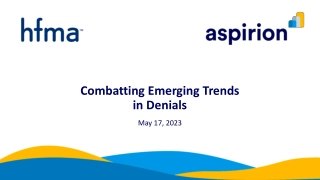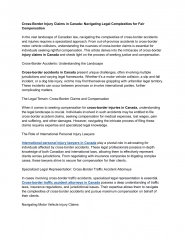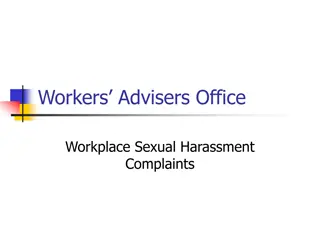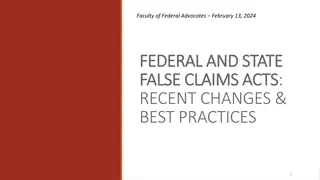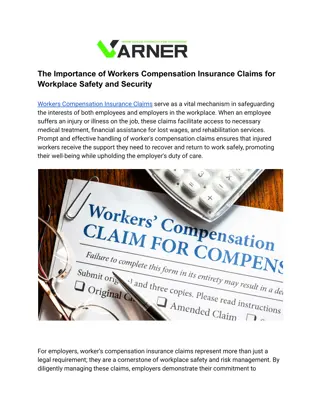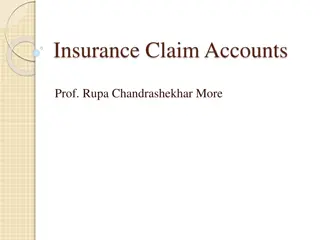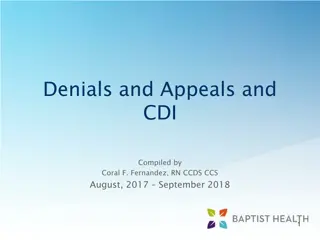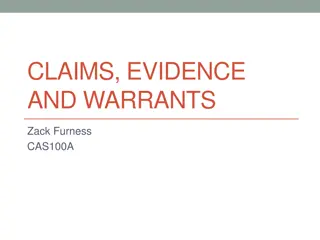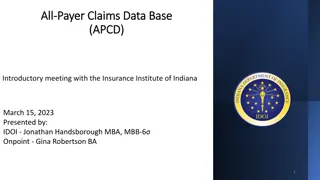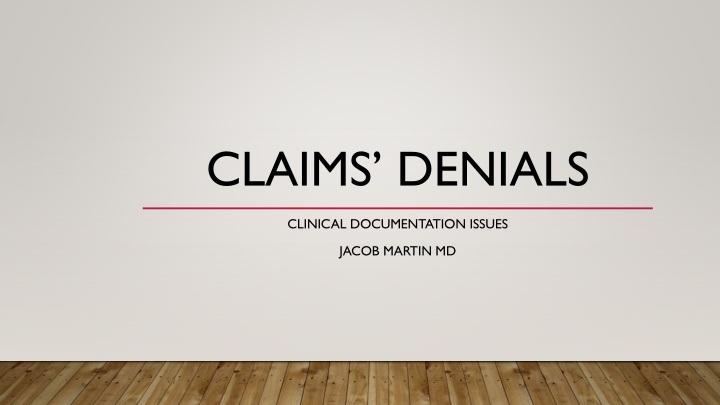
Claims Denials in Healthcare
Claims denials in healthcare, such as technical denials and level of care denials, can result from inadequate clinical documentation. Learn about major types of denials, including DRG denials, and how the Two Midnight Rule impacts inpatient care.
Download Presentation

Please find below an Image/Link to download the presentation.
The content on the website is provided AS IS for your information and personal use only. It may not be sold, licensed, or shared on other websites without obtaining consent from the author. If you encounter any issues during the download, it is possible that the publisher has removed the file from their server.
You are allowed to download the files provided on this website for personal or commercial use, subject to the condition that they are used lawfully. All files are the property of their respective owners.
The content on the website is provided AS IS for your information and personal use only. It may not be sold, licensed, or shared on other websites without obtaining consent from the author.
E N D
Presentation Transcript
CLAIMS DENIALS CLINICAL DOCUMENTATION ISSUES JACOB MARTIN MD
MAJOR TYPES OF DENIALS 1. TECHNICAL 2. LEVEL OF CARE DENIALS 3. DRG DENIALS
TECHNICAL DENIALS A technical denial is a denial of the entire paid amount of a claim in instances when the care provided to a member cannot be substantiated due to a healthcare provider s alleged non-response to carrier s requests for medical records, itemized bills, documents, etc.
LEVEL OF CARE AND DRG DENIALS A. RESULT FROM THE INSURANCE CARRIER S MEDICAL REVIEW OPINING THAT SUBMITTED MEDICAL DOCUMENTATION FAILED TO SATISFY THE CARRIER S DIAGNOSTIC CRITERIA OR LEVEL OF CARE CRITERIA B. THE DENIAL LETTERS UNIFORMLY ADVISE THAT THE SUBMITTED MEDICAL DOCUMENTATION WAS REVIEWED BY A LICENSED BOARD- CERTIFIED PHYSICIAN C. MEDICARE ADVANTAGE AND MANAGED MEDICAID PLANS ADVISE THAT THE CARRIER ITSELF DETERMINES WHAT DIAGNOSTIC CRITERIA MUST BE SATISIFED
TWO MIDNIGHT RULE (APPLIES TO ACUTE CARE HOSPITALS, CRITICAL ACCESS HOSPITALS, LONG-TERM CARE HOSPITALS, AND INPATIENT PSYCHIATRIC HOSPITALS) The Inpatient Prospective Payment System (IPPS) Two-Midnight Rule provides that surgical procedures, diagnostic tests, and other treatments are generally appropriate for inpatient hospital payment under Medicare Part A only when the physician expects the patient to require a stay that crosses at least two midnights, and the physician admits the patient to the hospital based on that expectation. The healthcare provider is expected to certify that the services were reasonable and necessary, including a medical reason for the inpatient admission. The physician must include an expected length of stay, a plan of care, and a plan for post-hospital care. Certification begins with the inpatient admission order that must be completed, signed, dated, and documented prior to the patient s discharge.
TWO MIDNIGHT RULE INPATIENT Level of Care: the healthcare provider s expectation of a two midnight or longer hospital stay guides the level-of-care determination. The expected length of stay and the patient s underlying medical necessity for hospital care must be supported in the medical record by factors such as: history and comorbidities severity of signs and symptoms current medical needs risk of adverse events
TWO MIDNIGHT RULE EXCEPTIONS for unforeseen circumstances such as: 1. a shorter length of stay: unexpected recovery than originally expected 2. death 3. transfer 4. departure against medical advice 5. election of hospice care
LEVEL OF CARE DENIALS 1. OBSERVATION STATUS: suitable when further evaluation is necessary to establish an accurate reflection of patient s severity of illness and determination of medical necessity for resource utilization particularly when it appears duration of stay will be less than 2 midnights 2. INPATIENT STATUS: when the stay is felt to be at least 2 midnights in duration. The expected length of stay and the patient s underlying medical necessity for hospital care must be supported in the medical record by such factors as: a. history and comorbidities b. severity of signs and symptom at presentation c. current medical needs (which would be expected to exceed OBSERVATION level of care) d. risk of adverse events if an INPATIENT level of care is not allowed
LEVEL OF CARE DENIALS SCENARIO A: patient is placed in OBSERVATION status, then is advanced to INPATIENT status: there should be clear documentation as to why the LOC was advanced SCENARIO B: patient is placed in OBSERVATION status, then is advanced to INPATIENT status (with expectation of inpatient stay of at least 2 midnights). However, patient is discharged prior to 2 midnight-stay: documentation should clearly delineate why the inpatient stay was shorter than expected.
LEVEL OF CARE DENIALS SCENARIO C: patient is initially admitted (INPATIENT status) with expectation of at least a 2 midnight-stay but discharged prior to 2 midnights duration stay: documentation should clearly delineate why the inpatient stay was shorter than expected.
DRG DENIALS A. PRINCIPAL DX* IS DISALLOWED (CHANGES THE DRG) B. A DX IS DISALLOWED: USUALLY AN MCC (MAJOR COMORBID CONDITION) OR A CC (COMORBID CONDITION OR COMPLICATION): USUALLY CHANGES THE DRG C. DRG CHANGE IS USUALLY TO A LOWER RELATIVE WEIGHT DRG *PRINCIPAL DX THAT CONDITION, AFTER STUDY, FELT TO HAVE CHIEFLY OCCASIONED THE PATIENT S ADMISSION (INPATIENT STATUS)
SPECIFIC DIAGNOSES FREQUENTLY DISALLOWED 1. SEPSIS/SEPTIC SHOCK 2. ACUTE ENCEPHALOPATHY (PARTICULARLY IN A SETTING OF DEMENTIA) 3. ACUTE RESPIRATORY FAILURE (ANY TYPE) 4. ACUTE RENAL FAILURE (WITH OR WITHOUT CHRONIC KIDNEY DISEASE) 5. MALNUTRITION (PARTICULARLY IF DESIGNATED AS SEVERE ) 6. PNEUMONIA (PARTICULARY IN A SETTING OF UNREMARKABLE CHEST IMAGING)
SEPSIS/SEPTIC SHOCK DENIALS (ALL MEDICARE ADVANTAGE PLANS REQUIRE SEPSIS-3 CRITERIA BE SATISFIED FOR CLINICAL VALIDATION), DENIAL RATIONALES INCLUDE: 1. Inconsistent documentation of sepsis in the medical record 2. Clinical presentation could have been explained by a LOCALIZED INFECTIOUS PROCESS OR BY A NON-INFECTIOUS PROCESS. 3. No documentation of sepsis-related organ failure-dysfunction due to a dysregulated response to infection: SOFA score 2 NOTE: effective 11/20/19, the state of KY mandated that Medica-id MCOs use SEPSIS-2 criteria NON-STARTERS: MEETS SEPSIS CRITERIA, UROSEPSIS, & NO INFECTIOUS SOURCE(S)
ACUTE ENCEPHALOPATHY (PARTICULARLY IN A SETTING OF DEMENTIA): DENIAL RATIONALES INCLUDE: 1. ABSENCE OF DOCUMENTATION OF SUSPECTED CAUSE(S) AND TYPE 2. ABSENCE OF CLINICAL INDICATORS TO SUPPORT THIS DX 3. IN SETTING OF DEMENTIA, ABSENCE OF DOCUMENTATION OF HOW ACUTE PROCESS DIFFERS FROM CHRONIC UNDERLYING DEMENTIA BASELINE 4. INCONSISTENT CLINICAL DOCUMENTATION OF THIS DX
ACUTE RESPIRATORY FAILURE (ANY TYPE): DENIAL RATIONALES INCLUDE: 1. Inconsistent documentation of acute respiratory failure (any type) in the medical record 2. Absence of objective medical evidence: pO2< 60 mm Hg or SpO2(pulse oximetry) < 91% breathing room air pCO2> 50 mm Hg and pH <7.35 (hypercapnic) P/F ratio (pO2/ FIO2) <300 pO2decrease or pCO2increase by 10 TO 15 mm Hg from baseline (if known) 3. No signs of respiratory distress such as tachypnea, tachycardia, accessory muscle use, inability to speak in complete sentences, retractions, cyanosis, etc. b. Abnormal ABG c. Abnormal pulse oximetry data 3. No explicit linkage of this DX to suspected cause(s)
ACUTE RESPIRATORY FAILURE (ANY TYPE) IN SETTING OF CHRONIC LUNG DISEASE A. in patient s with chronic lung disease, the following is also expected (per carrier medical reviews): 1. An increase in baseline PCO2 of 10-15 MM Hg and/or 2. A decrease in baseline PO2 of 10-15 MM Hg B. In the absence of ABG data, documentation of medical necessity for medical management above what would be necessary at clinical baseline: Increased O2 flowrate(s) or increased FIO2 requirement to maintain adequate O2 SATs and/or Bi-PAP
ACUTE RENAL FAILURE A PROFFERED DX OF ARF REQUIRES DOCUMENTATION WHICH MEETS KDIGO (Kidney Disease Improving Global Outcomes) CRITERIA: 1. increase in serum creatinine by 0.3 mg/dl or more within 48 hours (excludes patients with CKD); OR 2. Increase in serum creatinine to 1.5 times or more from baseline, which is known or presumed to have occurred within the prior 7 days (for those with or without CKD); OR 3. Urine volume < 0.5 ml/kg/h for 6 hours (applies only when no urinary obstruction is present)
ACUTE RENAL FAILURE WITH CKD AKI/ARF in CKD is defined according to CKD stage (currently used by insurance carriers to clinically validate AKI/ARF in setting of CKD): 1. STAGE 1: 0.3 MG/DL increase in creatinine over 24 HRS or 0.5 MG/DL increase over 48 HRS 2. STAGE 2:0.5 MG/DL increase in creatinine over 24 HRS or 1.0 MG/DL increase over 48 HRS 3. STAGE 3:1.0 MG/DL increase in creatinine over 24 HRS or 1.5 MG/DL increase over 48 HRS 4. STAGE 4:based on research limits of original study, use stage 3 parameters
MALNUTRITION: DENIAL RATIONALES INCLUDE: 1. INCONSISTENT DOCUMENTATION 2. ABSENCE OF DOCUMENTATION OF CLINICAL INDICATORS a. Subjective data (e.g. information relative to appetite/current eating habits) b. Reported weight loss (intentional or not) c. Muscle and/or subcutaneous fat atrophy/wasting 3. ABSENCE OF DOCUMENTATION OF MEDICAL MANAGEMENT
PNEUMONIA: ABSENCE OF DOCUMENTATION OF OBJECTIVE MEDICAL DATA WHICH MAY INCLUDE: 1. Clinical presentation: fever, cough, respiratory distress, etc. 2. Abnormal pulmonary physical examinational findings 3. Abnormal chest imaging findings 4. Supporting diagnostic laboratory findings (e.g. leukocytosis, positive antigen testing, etc.) 5. Supporting microbiological findings (e.g. positive sputum culture, positive bronchoalveolar washing culture, etc.) 6. Consistently asserted medical opinion(s) throughout the medical record
PNEUMONIA: SPECIFIC TYPES Specific etiological types of pneumonias are denied unless: 1. There is explicit linkage of reported positive culture results or urinary antigen assays (e.g. M. pneumoniae) with the DX of pneumonia (merely citing the culture results along with citing pneumonia is INSUFFICIENT). 2. There are identified clinical risk factors (e.g. chronic lung disease, increased aspiration risk, [e.g. stroke residual with impaired swallowing, altered mental status, GERD, etc.], immune suppression, socioeconomic factors, etc.)
MYOCARDIAL INFARCTION: DENIAL RATIONALES INCLUDE: ABSENCE OF DOCUMENTATION CONSISTENT WITH THE ACC S FOURTH UNIVERSAL DEFINITION OF MYOCARDIAL INFARCTION
BEWARE OF COPY AND PASTE FUNCTIONALITY (W/O CONCURRENT EDITING) Copying and pasting inaccurate or outdated information Redundant information in the EHR, which makes it difficult to identify the current information Inability to identify the author or intent of the documentation Inability to identify when the documentation was first created Propagation of false, temporally incorrect, or nonsensical information Internally inconsistent progress notes Unnecessarily lengthy progress notes NOTE BLOAT: lengthy progress notes that prevent timely and efficient communication: patient s current clinical story is lost Failure to establish medical necessity for services billed with ensuing claims denials and loss of revenue Increased medico-legal risk
SAMPLE CLAIMS DENIALS CASE 1: denial of inpatient level of care (LOC) due to opined failure to establish medical necessity for same CASE 2: disallowance of the proffered DX of acute respiratory failure with hypoxia due to opined failure to establish clinical validation for same

